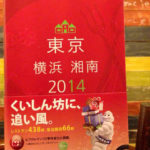
Sea pineapples are irreplaceable. It is definitely better to know about them.
To start with, the sea pineapples are served plain to better understand the underlying palate. Typically, sashimi is eaten with shoyu (soy sauce) and wasabi (horseradish) condiments, so it is rather unusual to sample this unembellished.
As a marine product, it is no surprise that sea pineapples have a slightly salty flavor. But beyond that, they are blessed with all five basic tastes; in other words, bitter, sweet, sour and umami (savory) as well. Chef (Kiyomi) Mikuni also said that the sea pineapples he ate when he was small had a significant influence on his later sense of taste. I think it is interesting to sense how the taste changes if salt, for example, is added after experiencing the original taste.
I can be confident serving this “as-is” thanks to these sea pineapples. Such ingredients are really rare, and I can’t imagine what could replace them. Not only are they delicious by themselves, but they also enhance other tastes. Moreover, they generate new developments through combination. The taste of water – in particular – is really enhanced. I am especially interested in how the flavor is enhanced in the mouth when combined with drink.
Many people may think of sake when I mention its compatibility with water. Tastes seem different before and after having sea pineapples even when drinking fresh water. Needless to say – if even water tastes different, the taste of sake is markedly more different. Sea pineapples are the sort of dish that if eaten after drinking sake, make you feel like trying some more sake. For first-timers, not only are they delicious, but also an incredible and unique dining experience.
In fact, I believe sea pineapples are almost never used in French cuisine. That is why I wanted to try them. This ingredient has so many characteristics. It is definitely better to know about sea pineapples.


Decide what to “focus on” for first-time ingredients
I’m sure some readers will know nothing at all about sea pineapples. We often adopt a way of thinking that boils down to: “Which part of the ingredient is to be focused on?” when using ingredients for the first time. For example, some people call sea pineapples “hoya-gai”. If we feel it is like kai (shellfish), one might imagine, “It can be steamed with sake, or served as sashimi, etc.” When we feel it smells like the ocean, we start to cross-reference to other similar ingredients.
If we imagined it to be like oyster, we’d consider how to eat it; for example, fresh as sashimi, fried, or gratin. This is how our imagination flows.
I think sea pineapples offer infinite possibilities, although that may sound a bit exaggerated. It can be served as sashimi, shiokara (salted fish guts), or tempura (deep fried) – which means it is delicious both raw and cooked, and also goes well with oil. As such, it is definitely well suited to western cuisine, such as French dishes.
Some of these dishes are served raw, and some are cooked, so the texture varies. Regardless of how it is prepared, however, one of the characteristics of sea pineapples is that the texture remains consistent. Sea pineapples are sea pineapples in any form. This is something that is not easily found in other ingredients.
Conceptually, I put value on enhancing the actual ingredients. I want our customers to feel, “I enjoyed the taste (of that particular ingredient),” rather than, “I enjoyed a delicious dish.” Of course, I aim to create delectable dishes, especially with outstanding centerpiece ingredients, regardless of whether sea pineapples, potatoes, or meat, but I want their memory to be: “Oh, the sea pineapple I had at that restaurant was fantastic.”


No preconceived concepts about sea pineapples. Unharness their potential through flexible ideas.
I have been trying to incorporate sea pineapples into many different dishes. Since they are not very widely known about, there are no fixed concepts, so we are free to be as inventive as we want. I have already tried making ceviche in combination with avocado, so next I’d like to try it with fruit. “Does sea pineapple actually go well with regular pineapple?” (laughs) It’s easy for me to enjoy my work.
Many French dishes originally included fruit. I heard it has recently been used more in Asian dishes. Combining with popular Asian dishes or ingredients is another interesting angle. Tropical fruits, such as ripe papaya, sound delectable. I’m not sure whether mango would work, but it’ll be interesting to try. Matching with juicy ingredients is originally good, so new prospects may be found. I am always confident to create delicious dishes.
[ Previous ] Today’s menu (4 types)
Marusho K.K.
5-2-1 Tsukiji, Chuo-ku, Tokyo 104-0045
03-3543-6471

bistrot13que
Everyday French dishes can be enjoyed at this bistro. This is an intimate and convenient venue where adults can enjoy full-course meals – or just wine and snacks.
Please enjoy really delicious additive-free home-made dishes, with tasty drinks.

Included as an “excellent eatery for under ¥5,000” amongst French and Italian restaurants in Tokyo under the Bib Gourmand category that has been adopted in Japan since the 2014 edition of the “Michelin Guide for Tokyo, Yokohama, Shonan.” Introduced as “BGM, screen images, and used solid flooring, etc. create a relaxing atmosphere. Regular menu offers pate de champagne (country-style pate). Sausages and cassoulet are also popular. We recommend ordering some “starters” at first. Great place to just casually drop in as well. This is a nice feature of the neighborhood.” (Abstract from 2014 Michelin Guide for Tokyo, Yokohama, Shonan”)
